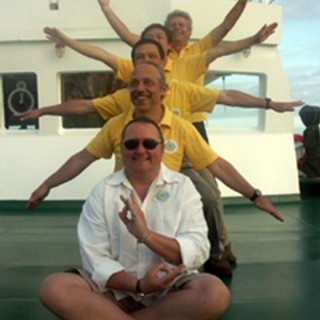
Chris German has been exploring the deep ocean for hydrothermal systems for nearly as long as anyone even knew such things existed. He has a BA in Geological Sciences (1984) and a PhD in Marine Geochemistry (1988) from the University of Cambridge, UK and it was during his PhD years that his colleagues from the Bullard Labs were part of the team that discovered first evidence for Black Smokers anywhere in the Atlantic. As soon as he completed his PhD Chris moved to the US, with funding from the Royal Society and NATO to take up a Post Doctoral Research Fellowship at MIT (1988-90). It was during this time that he got his first chance with WHOI’s Human Occupied Vehicle, Alvinto dive to vent-sites at the seafloor.
Over his career, Chris has spent more than 3 years on the high seas, spanning 50 research expeditions from the Arctic to the Antarctic, diving in US, French and Japanese submersibles in the Pacific, Atlantic and Indian Oceans. His first expedition as chief scientist was on an Icelandic research ship searching for hydrothermal activity along the Reykjanes Ridge but it was his second expedition in charge, to the Mid-Atlantic Ridge south of the Azores, that has most bearing on this year’s expedition. During that cruise, his team revealed evidence for hydrothermal activity where it shouldn’t exist, in the absence of fresh lava flows but flowing along faults that penetrated deep beneath the seafloor. One of these sites, Rainbow, is now one of the larger known vent-fields anywhere on the planet and the discovery was sufficiently surprising that it remains the only locale where both the Alvin submersible and its French counterpart Nautile showed up to dive on the same day! While finding vents in un-promising locations has since become one of Chris’ fortes (he subsequently pioneered the exploration for vents along even slower spreading ridges in the SW Indian Ocean and high Arctic) his particular interest in these fault-controlled systems is the potential they hold to promote abiotic organic synthesis and, hence, offer unique insights into the origins of life on Earth and beyond.
In addition to his geochemical research, Chris also works part time at WHOI as the Chief Scientist for Deep Submergence which requires him to interact closely with the engineers working on established (e.g. Alvin) and emerging (e.g. Nereus) deep ocean technologies – as well as interfacing directly with scientists who make use of WHOI’s deep submergence vehicles from all over the US and beyond. In the past decade he has also served as the Chair or Co-Chair of both InterRidge (2007-2009) and the Census of Marine Life program dedicated to investigating the biogeography and biodiversity of cold seep and vent animals, worldwide (2003-2010) – a task that, at its core, required a lot of exploration to find the host vents in the first place!!!
This Summer will see Chris’ 4th return to the Mid-Cayman Rise in as many years. For a place where he at first thought there was only a 50:50 chance of finding any vents he has been pleasantly surprised by the interest the region has attracted. So much so that, just as at Rainbow in 1996, this Summer’s cruise will be one of those rare occasions when two different nations’ submersibles converge on the same spot: HROV Nereus and Japan’s Shinkai 6500 vehicle. Chris hasn’t sailed with the Shinkai since dives to the SW Indian Ocean in 1998 but is looking forward to waving to his colleague and fellow Chief Scientist, Ken Takai (from JAMSTEC), across the ocean!
Cruises:
